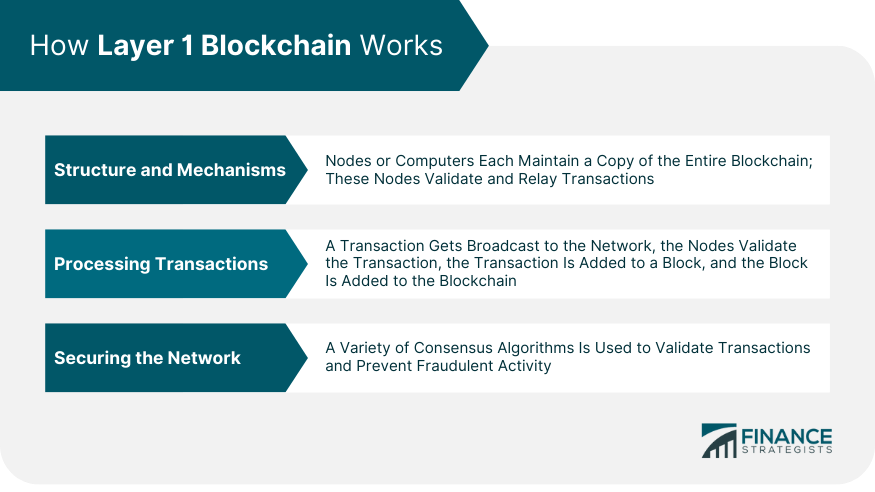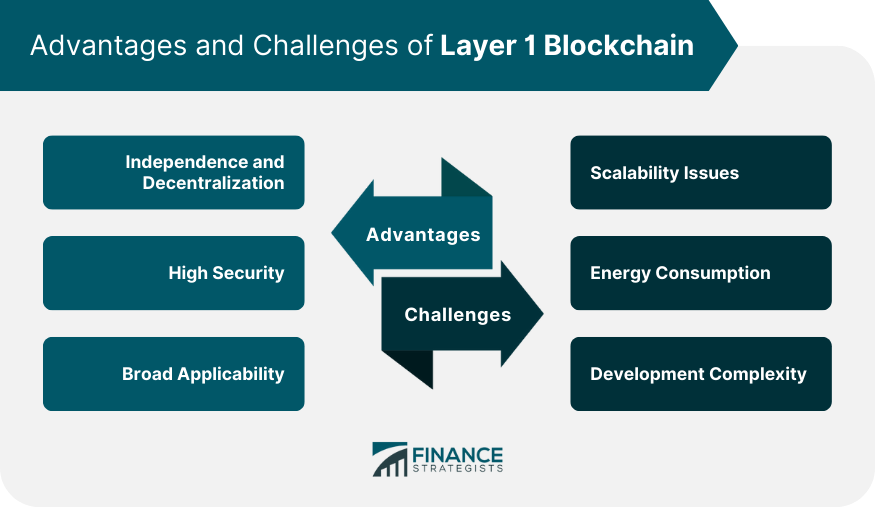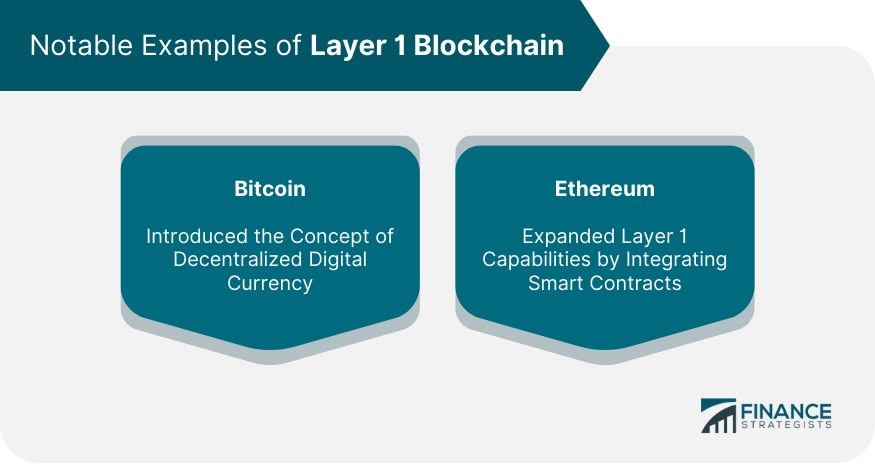Layer 1 blockchain refers to the base architecture of a blockchain system, providing the fundamental protocol upon which all network activities occur. It is where the blockchain's core operations, including transaction validation, consensus mechanisms, and data storage, happen. This foundational layer is decentralized, ensuring that no central authority can control the system, fostering transparency and security. Crucially, Layer 1 is where cryptocurrencies, like Bitcoin and Ethereum, exist and where smart contracts are deployed. However, it faces challenges, including scalability and high energy consumption. Despite these issues, Layer 1 blockchain continues to be essential, serving as the groundwork for blockchain applications across various industries and driving advancements in decentralized finance (DeFi). Layer 1 is crucial because it ensures the fundamental principles of blockchain technology - decentralization, security, and transparency. It's the foundation upon which all blockchain activities and applications are built. Layer 1 is where cryptocurrencies like Bitcoin and Ethereum reside, and it's where smart contracts - self-executing contracts with the agreement directly written into the code - are deployed and run. The Layer 1 structure consists of nodes or computers, that each maintain a copy of the entire blockchain. These nodes validate and relay transactions, keeping the network secure and running. Each block contains a list of transactions, and these blocks are chained together in a linear, chronological order, creating the blockchain. When a transaction occurs, it's broadcast to the network. The nodes validate the transaction using the network's consensus algorithm, and once validated, the transaction is added to a block. This block is then added to the blockchain, finalizing the transaction. Security is a cornerstone of Layer 1 blockchains. They use a variety of consensus algorithms (Proof of Work, Proof of Stake, etc.) to validate transactions and prevent fraudulent activity. Nodes in the network must agree on the validity of transactions, making it very difficult for malicious actors to alter the blockchain. One of the primary advantages of Layer 1 blockchain lies in its intrinsic property of decentralization. As the fundamental layer, it operates independently of any external control, removing the need for third-party intermediaries. This creates a transparent and fair environment for peer-to-peer transactions. Layer 1 blockchains uphold the highest security standards, making them virtually immune to cyber-attacks. Once the data is validated and added to the chain, it's almost impossible to alter due to the consensus mechanism's nature. This inherent security feature is particularly beneficial for sensitive transactions. Layer 1 blockchains serve as a platform for a multitude of applications, spanning industries from finance to healthcare, supply chain management, and beyond. They provide the groundwork for cryptocurrencies and DeFi, contributing significantly to the broader blockchain ecosystem. Despite the advantages, Layer 1 blockchains face scalability challenges. As every transaction is processed on the base layer, the network can become congested during peak times, leading to slower transaction times and higher costs. This issue is a key obstacle to blockchain technology's mass adoption. Certain Layer 1 blockchain, particularly those using proof-of-work consensus algorithms like Bitcoin, are notorious for their high energy consumption. This environmental impact is a significant challenge for such networks, spurring the search for more sustainable alternatives. Developing Layer 1 solutions is complex and requires extensive knowledge and expertise in blockchain technology. It can be a time-consuming and resource-intensive process, adding to the challenges of Layer 1 blockchain. The first and most well-known example of a Layer 1 blockchain. It introduced the revolutionary concept of decentralized digital currency and laid the foundation for subsequent blockchain developments. Took the Layer 1 concept a step further by introducing smart contracts. It has become a popular platform for decentralized applications (dApps), fostering a vibrant ecosystem of blockchain-based solutions. Decentralized Finance, or DeFi, represents a shift from traditional, centralized financial systems towards an open, transparent, and permissionless financial ecosystem built on blockchain technology. DeFi applications aim to replicate and improve upon the financial services currently available in traditional banking and finance, such as lending, borrowing, and trading. Layer 1 blockchains play an essential role in the development and operation of DeFi applications. These blockchains provide the underlying infrastructure that DeFi applications are built on. For example, many DeFi applications are currently built on the Ethereum blockchain, leveraging its Layer 1 infrastructure to execute smart contracts and perform transactions. As DeFi continues to grow and evolve, the importance of Layer 1 blockchains is set to increase. These foundational blockchains will continue to provide the necessary infrastructure for the development of new DeFi applications, as well as the secure and transparent execution of transactions. Additionally, innovations in Layer 1 technology, such as Ethereum's transition to Ethereum 2.0, are focused on addressing current limitations and ensuring that these blockchains can support the continued growth and complexity of DeFi applications. Layer 1 blockchain form the essential infrastructure of the broader blockchain and cryptocurrency ecosystem. They provide the foundation for all blockchain activities and applications, ensuring decentralization, security, and transparency. Despite facing challenges such as scalability and high energy consumption, Layer 1 blockchains continue to be at the forefront of technological advancements in the field. Their role is particularly significant in the burgeoning DeFi sector, where they underpin the operation and development of innovative financial applications. As the blockchain industry continues to evolve, the importance of Layer 1 solutions in driving this technological revolution will undoubtedly remain paramount.What Is Layer 1 Blockchain?
Purpose and Importance
How Layer 1 Blockchain Works
Structure and Mechanisms
Processing Transactions
Securing the Network

Advantages of Layer 1 Blockchain
Independence and Decentralization
High Security
Broad Applicability
Challenges of Layer 1 Blockchain
Scalability Issues
Energy Consumption
Development Complexity

Notable Examples of Layer 1 Blockchain
Bitcoin
Ethereum

Layer 1 Blockchain's Role in Advancing Decentralized Finance
Introduction to Decentralized Finance (DeFi)
Interaction With Layer 1 Blockchains
DeFi's Future Impact and Layer 1 Blockchain's Role
Conclusion
Layer 1 Blockchain FAQs
Layer 1 blockchain refers to the base layer or the foundational architecture of a blockchain system. It's where core blockchain operations, such as transaction validation, consensus mechanisms, and data storage, occur.
Layer 1 is crucial for ensuring the fundamental principles of blockchain technology - decentralization, security, and transparency. It serves as the base for all blockchain activities, including cryptocurrencies and smart contracts, and drives innovations in various industries.
Layer 1 blockchain faces scalability issues, as all transactions are processed on this base layer, leading to possible network congestion. Other challenges include high energy consumption, particularly in proof-of-work consensus mechanisms, and the complexity of developing Layer 1 solutions.
Bitcoin and Ethereum are prominent examples of Layer 1 blockchains. Bitcoin introduced the concept of decentralized digital currency, while Ethereum extended the Layer 1 concept by integrating smart contracts.
Layer 1 blockchains provide the underlying infrastructure that DeFi applications are built upon. They enable the execution of smart contracts and transactions, playing an integral role in the growth and operation of the DeFi ecosystem.
True Tamplin is a published author, public speaker, CEO of UpDigital, and founder of Finance Strategists.
True is a Certified Educator in Personal Finance (CEPF®), author of The Handy Financial Ratios Guide, a member of the Society for Advancing Business Editing and Writing, contributes to his financial education site, Finance Strategists, and has spoken to various financial communities such as the CFA Institute, as well as university students like his Alma mater, Biola University, where he received a bachelor of science in business and data analytics.
To learn more about True, visit his personal website or view his author profiles on Amazon, Nasdaq and Forbes.















